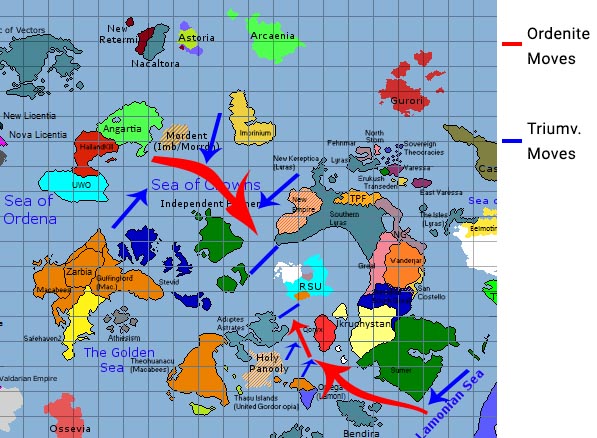Although the Arcaenian 1st and 9th fleets had badly mauled The Ordenite Task Forces Nord and Wiking, little did Arcaenian naval planners realize that those were merely diversionary forces intended to tie up the Triumverate in the northern part of the region while the bulk of the Ordenite Kriegsmarine made it's way south to the seas around Krasnova. To make matters worse after several days of around-the-clock operations the Arcaenian carriers had completely exhausted their supply of aircraft launched anti-ship missiles and the majority of their aviation fuel capacity in attacks against the Ordenite task forces. As turning back north and resupplying in Arcaenian ports would take days, if not weeks, the Arcaenian task forces were ordered to chase the Ordenites south, attacking them in piecemeal strike groups with bombs if need be and ensuring they couldn't turn west and escape back to Ordenite waters.
Further south two more Arcaenian fleets totaling some 4,000 warships when combined with the two fleets from the north (representing virtually the entire Arcaenian surface navy) and multiple Imbrinumian fleets with several thousand more ships were moving into the Sea of Crowns from the east. With multiple kríergrups already attacking the in the south and with an entire Kríermak Armada returning from Gothic waters about to enter the fray the Ordenite Kriegmarine was poised to fight a relentless battle on all sides in the Sea of Crowns and around RSU that would almost certainly lead to its virtual annihilation as a fighting force. When these forces made hostile contact with the Ordenite forces fleeing south the two Arcaenian fleets in pursuit from the north would be ordered to turn back towards Arcaenia and head to ports for resupply. These fleets would then be re-armed with land attack weaponry to replace their exhausted stocks of anti-ship missiles and head south where they would bombard targets in and around Krasnova to relieve the Triumvirate forces currently engaged in fighting in the Satrapy.
While the naval war raged on in the central Deinstad seas the Arcaenian Luftwehr was scheduled to begin it's strategic bombardment of Krasnova in support of the Triumverate forces currently under Siege in the Satrapy from Ordenite invasions. Flying the roughly 20,000 kilometers from Airbases in southern Arcaenia to targets in Krasnova and back meant multiple in-air refueling per trip with virtually every tanker in the Arcaenian Luftwehr assigned to support. Hundreds of Arcaenian B-3 and RB-80 supersonic strategic bombers, loaded with up to sixteen satellite guided 1,000 kilogram armor-piercing bombs each, would fly non-stop sorties attacking the Ordenite airfields in Krasnova to lessen the ability of the Ordenie Luftwaffe in Krasnova to carry out operations against Triumverate forces in the region. Escort in form of Seraph fighters would not be available, instead the Arcaenian bombers would have to rely on their extreme speed (The RB-80) or speed and radar low-observability (the B-3) and copious amounts of stand-in jamming to punch through Luftwaffe interceptors and Ordenite anti-air missile batteries. With bombing raids and air-superiority operations in Krasnova also being conducted by the Golden Throne and the Imbrinians from their own bases in the region and with the Ordenite Luftwaffe's inability to replace its losses in theater, soon the balance of air-power over Krasnova would shift in the favor of the Triumverate and the buildup of Triumverate forces in the Satrapy allowed to accelerate as planned.







